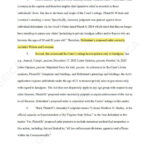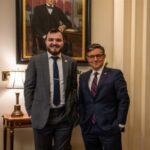
Mark Carlson walks past a gun rack holding his firearms at his home in Hammond, Wis., Wednesday, Sept. 28, 2022. "I'm not a big gun guy," says Carlson, whose weapons include pistols, a shotgun, an AR-15 rifle, 10 loaded magazines and about 1,000 additional rounds. "For a lot of people that's just a start." (AP Photo/David Goldman)
I spent much of the last week assisting my brilliant colleagues in preparing their supplemental brief in Duncan v. Bonta. This is the magazine-capacity case that kicked off the now-famous “freedom week” in California in 2019. Our win in district court was affirmed on appeal by a 3-judge panel, but then was reversed by the Ninth Circuit sitting en banc.
Thankfully, the Supreme Court acted on our appeal by vacating the en banc decision and remanding the case for further proceedings in light of Bruen.
Back in the district court, the Attorney General Rob Bonta submitted an overlong brief making all sorts of inane arguments, which our brief responds to quite well. However, one throwaway line from the Attorney General bugged me immensely . . .
In neither Heller nor Bruen did the Court find that the Second Amendment’s protections were grounded in the need to bear arms for militia service…or as a “check against tyranny”. In fact, Bruen repeatedly confirms that self-defense (and not militia or military service) is the “central component” of the right protected by the Second Amendment.
Personal self-defense is certainly a critical aspect of the Second Amendment, but both the founders as well as the generations immediately after them considered one other purpose paramount: a final defense against a tyrannical government that attempts to overthrow our constitutional order.
This idea, once accepted as common knowledge, has become controversial. It has been derided by modern day gun control advocates as the “insurrectionist theory” of the Second Amendment that was invented by the NRA in the 1970s.[1]
Yet it certainly wasn’t invented by the NRA, nor is it some tinfoil hat theory. It instead goes to the very core of what the Second Amendment was intended for, as the historical record is indisputable on this point.
Embarrassing as it may be to admit for some polite society academics of today, the Bill of Rights was written by people who just finished violently overthrowing their former government. Based on that experience, they were obviously very fearful of the new government they were forming becoming tyrannical, and so they included the Second Amendment, in part, as a failsafe.
You don’t need to take my word for it – the Founders said so themselves. James Madison tried to assuage fears of a tyrannical federal army running roughshod over the people in one of his many Federalist Papers:
Let a regular army, fully equal to the resources of the country, be formed; and let it be entirely at the devotion of the federal government…To these would be opposed a militia amounting to near half a million of citizens with arms in their hands, officered by men chosen from among themselves, fighting for their common liberties, and united and conducted by governments possessing their affections and confidence. It may well be doubted, whether a militia thus circumstanced could ever be conquered by such a proportion of regular troops. Those who are best acquainted with the last successful resistance of this country against the British arms, will be most inclined to deny the possibility of it. Besides the advantage of being armed, which the Americans possess over the people of almost every other nation, the existence of subordinate governments, to which the people are attached, and by which the militia officers are appointed, forms a barrier against the enterprises of ambition, more insurmountable than any which a simple government of any form can admit of…[2]
Likewise, Alexander Hamilton added that, should a large army ever be raised, “that army can never be formidable to the liberties of the people while there is a large body of citizens, little, if at all, inferior to them in discipline and the use of arms, who stand ready to defend their own rights and those of their fellow-citizens.”[3]
Tench Coxe, a friend of Madison and himself a delegate to the Constitutional Convention, wrote that “Whereas civil rulers, not having their duty to the people duly before them, may attempt to tyrannize, and as the military forces which must be occasionally raised to defend our country, might pervert their power to the injury of their fellow citizens, the people are confirmed by the article in their right to keep and bear their private arms.”[4]
Given this guiding purpose of the Second Amendment, it follows that excluding from the right so-called “weapons of war” makes no historical sense, particularly in a country where there is a long tradition of widespread lawful ownership of such weapons.[5] What’s more, this view of the Second Amendment as a guard against tyranny remained the prevailing one throughout the 19th century, as a plethora of writers from the era confirm.
In particular, note how matter-of-factly these excerpts are phrased. These writers plainly did not believe they were saying anything controversial in the least, and a number of these books were textbooks meant for students, not screeds by fringe radicals.
- “[The Second Amendment] may be considered the true palladium of liberty…Wherever standing armies are kept up, and the right of the people to keep and bear arms is, under any colour or pretext whatsoever, prohibited, liberty, if not already annihilated, is on the brink of destruction.” St. George Tucker, Blackstone’s Commentaries: With Notes of Reference to The Constitution And Laws, of the Federal Government of the United States; and of the Commonwealth of Virginia, at 300 (1803);
- “Some tyrannical governments resort to disarming the people, and making it an offence to keep arms, or participate in military parades. In all countries where despots rule with standing armies, the people are not allowed to keep guns and other warlike weapons.” Joseph Bartlett Burleigh, The American Manual: Containing an Outline of the Origin and Progress of Political Power, and the Laws of Nations, at 212 (1848) (emphasis added);
- “If citizens are allowed to keep and bear arms, it will be likely to operate as a check upon their rulers, and restrain them from acts of tyranny and usurpation.” Furman Shepherd, The Constitutional Text-book: A Practical and Familiar Exposition of the Constitution of the United States, and of Portions of the Public and Administrative Law of the Federal Government, at 245 (1855);
- “With arms in their hands, the people will not be likely to permit the overthrow of their institutions by the unscrupulous ambition of a civil magistrate or military chieftain.” Henry Flanders, An Exposition of the Constitution of the United States – Designed as a Manual of Instruction, at 258 (1860)
- “It is scarcely necessary to say, that the right of the people thus to bear arms is the foundation of their liberties; for, without it, they would be without any power of resistance against the existing government.” Edward D. Mansfield, The Political Manual; Being a Complete View of the Theory and Practice of the General and State Governments of the United States, at 205 (1861);
- “But a militia would be useless unless the citizens were enabled to exercise themselves in the use of warlike weapons. To preserve this privilege, and to secure to the people the ability to oppose themselves in military force against the usurpations of government, as well as against enemies from without, that government is forbidden by any law or proceeding to invade or destroy the right to keep and bear arms.” John Norton Pomeroy, LL.D., An Introduction to the Constitutional Law of the United States – Especially Designed for Students, General and Professional, at 152 (1868) (emphasis added);
- “Right to Keep Arms – This means the right of every one to own and use, in a peaceful manner, warlike weapons. Congress is forbidden to pass any law infringing the right. It was thought that without it, ambitious men might, by the aid of the regular army, overthrow the liberties of the people and usurp the powers of government.” Andrew White Young, The Government Class Book; A Youth’s Manual of Instruction in the Principles of Constitutional Government and Law, at 185 (Effingham Maynard & Co. 1889) (1880) (emphasis added);
- “The right to bear arms is not herein granted, but only protected from infringement…This clause is based upon the idea that the people cannot be oppressed or enslaved who are not first disarmed.” Robert Desty, The Constitution of the United States, at 255 (2d ed. 1884);
- “The right declared was meant to be a strong moral check against the usurpation and arbitrary powers of rulers, and as necessary and efficient means of regaining rights when temporarily overturned by usurpation.” Thomas M. Cooley, LL.C., The General Principles of Constitutional Law in the United States of America, at 298 (1898).
More examples can certainly be found. What’s perhaps most fascinating is that the commentators who embraced some gun control laws in the 19th and early 20th centuries were still clear that “weapons of war” were protected by the Second Amendment. Perhaps the government could stop you from carrying a small pistol concealed (though open carry was generally allowed), but it couldn’t block your possession of the most effective weapons of the day.
A few examples . . .
- “[T]he provision protects only the right to ‘keep’ such ‘arms’ as are used for purposes of war, in distinction from those which are employed in quarrels and brawls and fights between maddened individuals.” Joel Prentiss Bishop, Commentaries on the Criminal Law Volume 2, at 74-75 (4th ed. 1868) (emphasis added);
- “This clause does not mean that only organized state militia may keep and bear arms, but it means that every citizen may do so[…] However, it does not mean that men are allowed to carry concealed weapons.” Laura Donnan, Our Government Brief Talks to the American Youth on Our Governments, General and Local, at 238 (1900).
- “The ‘arms’ here meant are those of a soldier. They do not include dirks, bowie knives, and such other weapons as are used in brawls, fights, and riots. The citizen has at all times the right to keep arms of modern warfare…” Henry Campbell Black, M.A., Handbook of American Constitutional Law, at 543 (3d ed. 1910).
If even the famous original author of Black’s Law Dictionary believed that “arms of modern warfare” are protected, then clearly modern-day semiautomatic firearms fall under the Second Amendment’s scope.
Older court decisions also support this point. To reinforce its ruling that only weapons suitable for a citizen militia are protected by the Second Amendment, the Miller Court in 1939 cited Aymette v. State, an 1840 case from the Supreme Court of Tennessee, which explained that citizens “may keep arms to protect the public liberty, to keep in awe those who are in power, and to maintain the supremacy of the laws and the constitution…So the arms, the right to keep which is secured, are such as are usually employed in civilized warfare, and that constitute the ordinary military equipment.”[6]
The Supreme Court of Arkansas discussed this topic in 1876 as well: “It is manifest from the language of the article, and from the expressions of these learned commentators, that the arms which it guarantees American citizens the right to keep and to bear, are such as are needful to, and ordinarily used by a well regulated militia, and such as are necessary and suitable to a free people, to enable them to resist oppression, prevent usurpation, repel invasion, etc., etc.”[7]
Unfortunately, only a small handful of federal judges today will acknowledge this history. One was Judge Alex Kozinski, who retired in 2017. Dissenting from a decision to uphold an appellate panel ruling that the Second Amendment did not protect an individual right to bear arms, Judge Kozinski explained . . .
The prospect of tyranny may not grab the headlines the way vivid stories of gun crime routinely do. But few saw the Third Reich coming until it was too late. The Second Amendment is a doomsday provision, one designed for those exceptionally rare circumstances where all other rights have failed — where the government refuses to stand for reelection and silences those who protest; where courts have lost the courage to oppose, or can find no one to enforce their decrees. However improbable these contingencies may seem today, facing them unprepared is a mistake a free people get to make only once.[8]
It’s hard to put it better than that, so I won’t try. But regardless of what any modern judge says, Americans of the 18th and 19th centuries spoke for themselves. Whatever other arguments that may exist against modern semiautomatic firearms, they would be seen by the first generations of our Republic as the very weapons the Second Amendment protects most of all.
We are fortunate enough to live in a time where the idea that we may need to take up arms against a tyrannical government seems farfetched. I certainly hope that such a dark day never comes.
But even if it doesn’t in our lifetimes, we have been entrusted to protect this inheritance of liberty not just for ourselves, but for all generations to come. Americans of future generations, facing circumstances we can’t fathom, may indeed be very glad we did.
[1] See, e.g., Olivia Lee, The Gun Rights Rhetoric That Helped Seed the Insurrectionist Mindset, The Trace, (January 9, 2021), (as of November 11, 2022) (“There’s a theory of the Second Amendment called the insurrectionist theory. According to it, the Second Amendment preserves civilians’ right to bear arms so that they can take up arms against a tyrannical government, should the need arise…. Now, there are other historians who would say that that’s a tendentious reading of the history, at best, and that really nothing about the idea of the Second Amendment is actually designed to empower the people to overthrow the government. The insurrectionist theory wasn’t part of modern legal discourse until the 1970s, at the earliest. That was when the National Rifle Association went from being a sportsman’s organization to a very strong and inflexible gun-rights organization.”).
[2] The Federalist No. 46 (James Madison).
[3] The Federalist No. 29 (Alexander Hamilton).
[4] Remarks on the First Part of the Amendments to the Federal Constitution, under the pseudonym “A Pennsylvanian” in the Philadelphia Federal Gazette, June 18, 1789, p. 2 col. 1 (As quoted in the Federal Gazette, June 18, 1789.).
[5] The US government itself played a part in the distribution of them. For example, through the Civilian Marksmanship Program, and just between 1958 and 1967, the federal government sold approximately 207,000 M1 Carbines rifles, which came standard with 15-round and later 30-round magazines. See Stephen P. Halbrook, America’s Rifle: The Case for the AR-15, at 198 (Bombardier Books 2022).
[6] Aymette v. State, 21 Tenn. 154, 158 (1840).
[7] Fife v. State, 31 Ark. 455, 458 (1876).
[8] Silveira v. Lockyer, 328 F.3d 567, 569-70 (9th Cir. 2003) (Kozinski, J., dissenting from denial of rehearing en banc).
Konstadinos Moros is an Associate Attorney with Michel & Associates, a law firm in Long Beach that regularly represents the California Rifle & Pistol Association (CRPA) in its litigation efforts to restore the Second Amendment in California. You can find him on his Twitter handle @MorosKostas. To donate to CRPA or become a member, visit https://crpa.org/.





